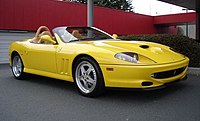Ferrari Maranello Series
| ||||||||||||||||||||||||||||||
The Ferrari 550 Maranello and 550 Barchetta are 2-seat grand tourers built by Ferrari. Introduced in 1996, the 550 was an upmarket front-engined V12 coupe of the kind not seen since the Daytona. It shared its platform and 5.5 L (5474 cc) engine with the 2+2 456 (Engine Code: F133) but was positioned as the company's highest-end model. The car used a transaxle layout, with the 6-speed manual gearbox located at the back, in-line with the driven wheels. The model number refers to total engine displacement (5.5 litres) and the model name of Maranello refers to the town where the Ferrari headquarters are located.
The demise that same year of the F512 M left the company with only the exotic F50 and V8 F355 as mid-engined models. Although the 550 was a softer GT model, it did take the place of the F512 M as the company's upmarket coupe, discounting the F50.
The 550 featured a luxurious and roomy interior. The (rear) trunk was tall and wide, though not very deep, and could accept a full set of golf clubs or standard overnight bags. It also had performance to look up at, with a top speed at 323 km/h (201 mph) and a 0–100 km/h acceleration time of just 4.5 seconds.
The 550 line was replaced by the Modificata 575 M Maranello in 2002.
Specifications
Engine
The 550 Maranello is a front-engined car. The engine is a naturally aspirated V12 with 4 valves per cylinder, and dual overhead cams. It displaces 5474 cc (334 in³) and produces 492 PS (485 hp, 357 kW) at 7000 rpm and 568.1 N·m (419 ft·lbf) at 5000 rpm.
Chassis
The 550 Maranello has a tubular steel frame chassis with light aluminum bodywork welded to it and 6-speed manual transmission. The steering is rack and pinion with variable power assist. The vented disc brakes are 330 mm (13.0 in) for the front and 310 mm (12.2 in) for the rear.
| Gear | 1 | 2 | 3 | 4 | 5 | 6 | Final Drive |
|---|---|---|---|---|---|---|---|
| Ratio | 3.15:1 | 2.18:1 | 1.57:1 | 1.19:1 | 0.94:1 | 0.76:1 | 3.91:1 |
Performance
The 550 Maranello can accelerate to 60 mph (97 km/h) in 4.2 seconds and can reach 161 kilometres per hour (100 mph) in 10.5 seconds. The ¼ mile (0.4 km) time is 13.1 seconds and the top speed is 320.3 kilometers per hour (199.0 mph).
550 Barchetta
Ferrari introduced a convertible version of the 550 at the Paris Motor Show in 2000. This Barchettawas a true roadster with no real convertible top provided. The factory did provide a soft top, but it was intended only for temporary use as it was cautioned against using the top above 70 mph (110 km/h). A total of 448 Barchettas were produced, four more than initially planned due to concerns of superstition in the Japanese market. The 448 cars were preceded by 10 prototypes numbered P01–P10 on their interior plaques. To an observer the prototypes and production cars are indistinguishable.
Rossa
The 550 based Ferrari Rossa was introduced at the 2000 Turin Motor Show to celebrate the 70th anniversary of Pininfarina.
550 GTZ
On October 28, 2009, Zagato and Ferrari revealed that they have been working on a drophead version of the GTZ to celebrate the 90th anniversary of the long collaboration between the two Italian establishments. The roadster GTZ is limited to five units and based on the 550 Barchetta Pininfarina. All five have been sold at the stratospheric price of £1 million (€1.1 million/ US$1.6 million) each.
Motorsport
Although not intended for motorsport, some privateer teams took it upon themselves to develop the 550 for use in various series. The first racing 550 was built for Red Racing to comply with FIA sporting regulations. Italtecnica aided in the development of the project. The car was termed a 550 GT and was first tested in April 1999. It was used in the FFSA GT Championship in France from the end of 1999 until the end of 2000. The car was then sold to XL Racing in 2001 who continued to develop the car. The 550 GT made one of its final appearances at the 2003 24 Hours of Le Mans. In 2000, Italtecnica would create another 550 race car meeting the more powerful GT regulations in the FIA GT Championship, but the car was short lived.
In 2001, Prodrive built racing customer versions of the 550 for various sports car series and especially the 24 Hours of Le Mans. However, although this brought the Ferrari name into the sport, the cars would be built entirely by Prodrive without any support from the Ferrari factory. Named the 550-GTS, a total of ten cars would be built over the next four years and campaigned by the Prodrive team as well as privateer customers.
The factory Prodrive team would win two FIA GT Championship races in the cars debut in late 2001. The BMS Scuderia Italia team would take over in FIA GT, recording four wins, while the Prodrive squad would take a single win the American Le Mans Series. 2003 would be the best year for the cars, as Prodrive won the GTS class at the 24 Hours of Le Mans, took second in the GTS class championship in the American Le Mans Series with four wins, and Scuderia Italia won the FIA GT championship with eight wins.
BMS Scuderia Italia would again take the FIA GT Championship with five wins in 2004, while Larbre Compétition would take the GT1 class championship in the new Le Mans Series. BMS Scuderia Italia would then move to the Le Mans Series as well and take that championship for 2005. At the same time, Prodrive would move to their next project, the Aston Martin DBR9. All 550-GTSs would be maintained by Care Racing, and a few continue to be used today. Convers MenX used a 550-GTS in the 2007 24 Hours of Le Mans, while Hitotsuyama Racing runs one in the full Japan Le Mans Challenge season.
Following the success of the 550-GTS, Ferrari would adapt the 575M for racing and offer it as a customer car for privateers. Some road legal Ferrari 550s would also be modified by small teams for racing, although these differed from the Prodrive-built 550-GTSs.
| ||||||||||||||||||||
| ||||||||||||||||||||
| ||||||||||||||||||||
575M Maranello
The Ferrari 575M Maranello is a two-seat, two-door, grand tourer built by Ferrari. Launched in 2002, it is essentially an updated 550 Maranello featuring minor styling changes from Pininfarina. The 575M was replaced by the 599 GTB in the first half of 2006.
Updates from the 550 include a renewed interior, but with substantial improvements mechanically, including bigger brake discs, a larger and more powerful engine, a different weight distribution, refined aerodynamics and fluid-dynamics and an adaptive suspension set-up (the four independent suspensions are also controlled by the gearbox, to minimize pitch throughout the 200-milliseconds shift time). Two six-speed transmissions are available, a conventional manual gearbox and, for the first time on a Ferrari V12, Magneti Marelli's semi-automatic (Electrohydraulic manual) 'F1' gearbox. The model number refers to total engine displacement in litres, whilst the 'M' is an abbreviation of 'modificato' or 'modified'.
For 2005, the company developed a new GTC handling package and Superamerica version (a limited run of 559 Retractable hardtop variants of the coupe), along with raising the power from 515 PS (379 kW; 508 hp) to 540 PS (400 kW; 530 hp).
Specifications
Engine
- Configuration: 65° V12 engine
- Displacement: 5.7 L (5748 cc/350 in³)
- Maximum power: 515 PS (379 kW; 508 hp) at 7,250 rpm
- Maximum torque: 588.6 N·m (434.1 lb·ft) at 5,250 rpm
Performance
- Maximum speed: 327 km/h (203 mph)
- 0 to 100 km/h (62 mph): 4.2 seconds
- 0–400 m: 12.25 seconds
- 0-1,000 m: 21.9 seconds
All figures are for the semi-automatic gearbox.
Dimensions
- Overall length: 4,550 mm (179 in)
- Overall width: 1,935 mm (76.2 in)
- Height: 1,277 mm (50.3 in)
- Wheelbase: 2,500 mm (98 in)
- Front track: 1,632 mm (64.3 in)
- Rear track: 1,586 mm (62.4 in)
- Curb weight: 1,730 kg (3,800 lb)
- Fuel capacity: 105 L (27.7 US gal)
GTC handling package
The GTC package includes Ferrari's fourth Carbon fibre-reinforced Silicon Carbide (C/SiC) composite ceramic composite brake system, made by Brembo (the first 3 being featured on the Challenge Stradale, F430 and Enzo) as well as a more performance-tuned suspension system, low-restriction exhaust system, and unique 19 inch wheels. The new brakes are based on the company's Formula One technology. They use 15.7 in discs with six-piston calipers in front and 14.2 in discs with four-piston calipers in the rear. The package is priced at US$23,500.
Superamerica
The Ferrari 575M Superamerica was an innovative convertible version of the 575M Maranello; it featured an electrochromic glass panel roof which rotated 180° (both are production car firsts) at the rear to lay flat over the boot. The Superamerica used the higher-output tune of the V-12 engine, rated at 540 hp (403 kW) and Ferrari marketed it as the world's fastest convertible, with a top speed of 199 mph (320 km/h). The GTC handling package was optional.
A total of 559 Superamericas were built; this awkward number followed Enzo Ferrari's philosophy that there should always be one fewer car available than what the market is demanding.
575 GTZ
A one-off special 575M was built by Zagato for Japanese Ferrari collector, Yoshiyuki Hayashi and announced at the 2006 Geneva Motor Show. Designed to recall the 250 GTZ (or 250 GT Zagato) and commemorate the 50th anniversary of the 250 range, the GTZ was officially endorsed by Ferrari and includes Zagato's trademark double-bubble roofline and two-tone paint.
Motorsports
In 2003, Ferrari announced the sale of several 575M-based racing cars, known as the 575-GTC (not to be confused with the 575M GTC Handling Package). Following the success of Prodrive in running the Ferrari 550, Ferrari wished to offer their own racing car to customers. Used primarily in the FIA GT Championship, the 575-GTCs managed to take a lone win in their first season, followed by another lone win in 2004. Unfortunately the 575-GTCs were not as capable as the Prodrive-built 550-GTSs, and would fall from use by the end of 2005.











![Validate my RSS feed [Valid RSS]](valid-rss-rogers.png)















































































ไม่มีความคิดเห็น:
แสดงความคิดเห็น